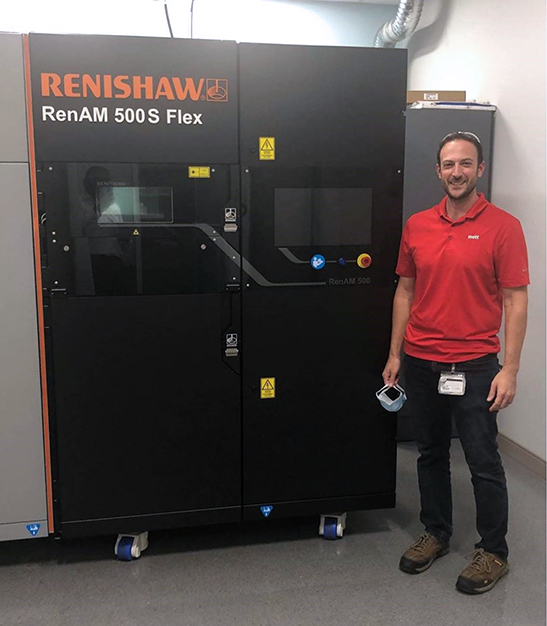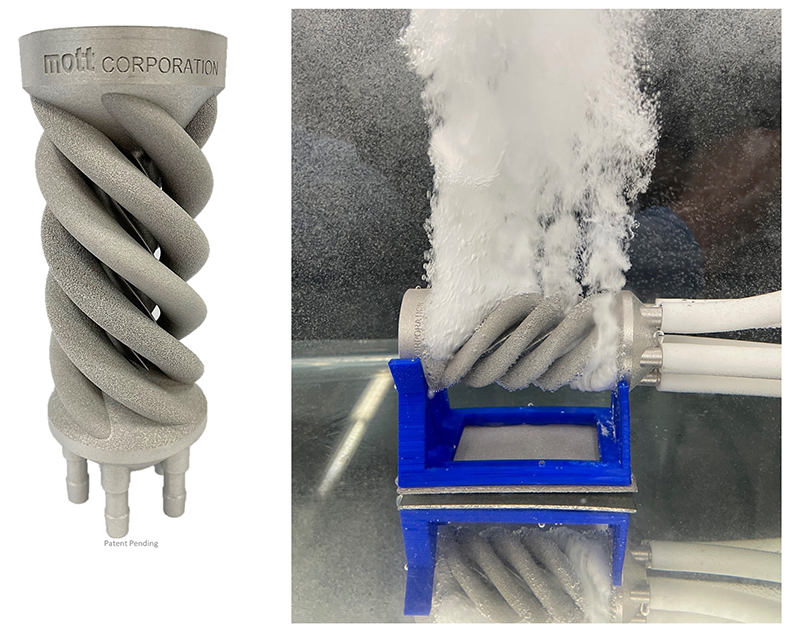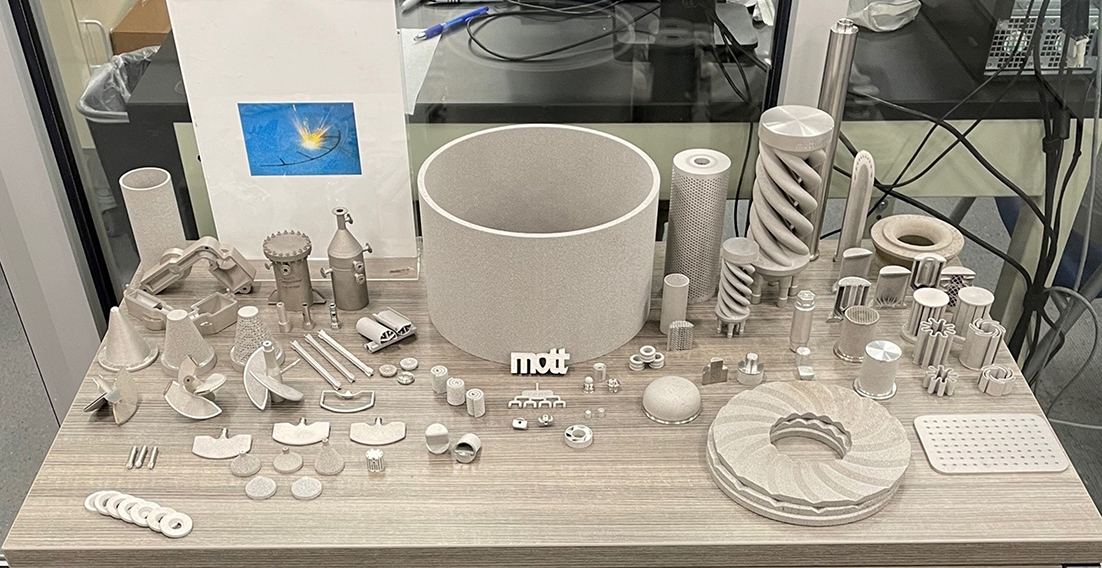High School to Advanced Manufacturing Development: Vincent Palumbo’s Journey to Mott Corporation
By Megan Andrew, Written Communications Assistant

Palumbo next to the Renishaw AM 500S Flex after its installation in the Mott Customer Innovation Center.
UConn MSE Alumnus Vincent Palumbo (PhD 2013) was inspired to enter the field of materials science and engineering after attending the E2K high school engineering program at UConn.
“It was a way to explore all the engineering disciplines at the university. You spent a week there in the summer, and we got to see all the engineering disciplines, from civil to environmental, mechanical, materials science, chemical, etc. Materials science was the one that stood out to me the most,” Palumbo said. “They had really interesting, hands-on demonstrations and discussed applications of various materials, how they are processed, and how some properties can be tuned to fit specific end uses.”
That E2K program was just the first step along an impressive career path for Palumbo, who is now Program Manager for Advanced Manufacturing Development at Mott Corporation.
Mott Corporation develops and sells filtration and flow control components across a wide variety of different industries. From orange juice shelf-life stabilization, to the treatment of wet macular degeneration, to electrolysis for green energy, to National Oceanic and Atmospheric Administration satellite longevity, Mott has a worldwide reach (and beyond…).
Palumbo is specifically responsible for vetting new equipment, collaborating with other companies in additive manufacturing, and working on root-cause failure investigations. “It’s a lot of responsibility pushing new, state-of-the-art technology acquisitions for our company. The company is growing very fast, which is great. I hope to be instrumental in getting our new capabilities up to speed, supporting production and research at the same time,” he said.
Palumbo’s ability to excel in this position has been 15 years in the making.
After sparking his initial interest in the E2K program, Palumbo decided to attend UConn for his undergraduate degree in 2004. The University had one of the top public programs for materials science, and Palumbo had access to state-of-the-art equipment and facilities. Palumbo recalled, “UConn had a lot of characterization equipment available to the students that were working at the time, and that was somewhat unique.”
After his first four years, Palumbo decided he wasn’t finished at UConn. His decision to pursue his PhD at UConn came easily, he said. “I liked the people there, the professors, and the program overall, so I honestly didn’t have much motivation to look elsewhere.”
Working with Professor Bryan Huey in the undergraduate labs also played a role in his continued education at UConn. “I really liked the work we were doing, I liked working for him in general, and I got to see a lot more of the university than I would have if just staying in course work. That really helped foster my interest in pursuing advanced degrees and staying in the UConn MSE program.”
After graduating with his PhD in 2013, Palumbo stayed at UConn for about a year as a postdoctoral fellow before moving on into the workforce. When a recruiter from Mott reached out to him, Palumbo found what he was looking for in a career. “I went for a tour and the interview, and I was impressed with what I saw. The capabilities in their lab, and the types of products they were making, were very interesting. So, I just took it from there, and here I am eight years later,” he explained.
Originally hired as a Metallurgist, Palumbo first focused on lab requests that would help solve production floor issues, quality issues, doing failure analysis, and root cause investigations. “You know, utilizing the materials science techniques that I had learned from my undergraduate and graduate careers at UConn,” he laughed.

An example of a printed component being used for gas-to-liquid mass transfer aka “sparging”. This part, created in a single build, features 5 independent elements with different porosities.
“I was able to come in having familiarity with most of the lab equipment in Mott’s R&D group. Tools like the scanning electron microscope, X-ray fluorescence system, and mechanical testing machines. I had experience with those techniques because of the curriculum at UConn and some of the research efforts that I did for my masters and PhD work, so I was able to hit the ground running. Many graduates from other universities are familiar with those same tools, but they didn’t get to run such equipment themselves. They had to give the samples to a grad student who would run it and give them the data. I think that’s a big benefit which UConn offers—access to all of the modern tools materials engineers use, gaining real research experience, and being hands-on. It really does pay off.”
From there, Palumbo moved into a Research Scientist role examining new capabilities development, where he worked with a team to “leverage new techniques and technologies, which we had not yet integrated into Mott, to make new or improved products for our company and clients,” he said, “One of those concepts was metal additive manufacturing. Through collaboration with service providers, equipment vendors, and the additive manufacturing center at UConn, I was able to narrow down what specific additive manufacturing technique and equipment manufacturer was the right fit for us. We then acquired the equipment, spent some time refining the processes, developed a range of media suitable for filtration and flow control applications, and started making prototypes for customers and small run production parts. The program is really taking off.”

Examples of the unique geometries and consolidation of parts made possible by the metal additive manufacturing process. These components all incorporate precisely controlled porosities for various filtration and flow control applications.
At the beginning of this year, Palumbo became the Program Manager for Advanced Manufacturing Development, where he identifies and proves out manufacturing and characterization equipment that supports Mott’s strategic growth and enables new fabrication capabilities. “There are ten different vendors that are going to make the same machine. It is important to consider how we compare those and know which is the right fit for us in terms of everything from the capabilities of the machine, its footprint, the resources required to operate it, and the level of technical support that the equipment manufacturer offers. Then, work on the logistics of how to bring those pieces in and implement them into the workflow of our facility.”
It’s his favorite part about the job. “It’s a longer process, it has its ebbs and flows of whether it’s going to pan out or not, but when you finally do get the approvals, and you can justify the expenses, you can make a case for why we need a particular piece of equipment. Once you have that thing working out on the floor and people can see its benefits, that’s very fulfilling,” he said.
Palumbo also collaborates with other companies that are doing additive manufacturing. “We can leverage our strengths, and theirs, to come together to advance what we’re trying to do in the world of additive manufacturing, supporting our ultimate efforts of filtration and flow control,” he said. To do this efficiently, Palumbo said he often draws from different interdisciplinary and collaborative work he did in the UConn labs.
Although in a more managerial role, Palumbo still appreciates root-cause investigations around the lab as one of the most rewarding parts of his position at Mott. “That means finding why something failed and how we can prevent it in the future: Is it back to the raw materials stock, is it a part of the processing parameters, or was it simply just a mistake that somebody made? Going through all those possibilities, putting together the timeline of how and why something happened, and identifying how we can grow and be better in the future to avoid similar issues, that’s really rewarding,” he said.
Palumbo offered some advice to students looking to find a company and career path where they will be consistently excited to go to work.
“Do the internships as early as you can. Don’t be afraid. Just put yourself out there, talk to people, go to the career fairs, do undergraduate student research if it’s available, work with a professor for a couple of semesters, get that experience because that really does stand out,” he said. “It doesn’t have to be the exact thing you are learning about in a course. If there is something that interests you and you can relate it somehow, go after that, because that’s just going to make you better at your future jobs. If you truly have an interest in what you are doing, it’s a lot more rewarding.”
Department head Huey notes “Dr. Palumbo’s comments echo what so many of our alumni tell us…about the importance of hands-on experience, and in enjoying what you do. That’s one reason one UConn MSE undergraduates earn more in-lab credits than in any other engineering major on campus. We recognize the value of these experiences, and how they help students be prepared for internships and future jobs. And there isn’t a program in the country with newer or more impressive facilities. That includes 4744 square feet and >$500k of recent equipment investments exclusively for our undergraduate labs. And this is amplified 50-fold across the more research-focused rest of the new Science1 building, along with the already-impressive resources at IPB and C2E2.”
Huey says, “Most of all, it’s exciting to see the contributions our alumni like Vincent are making as materials engineers.”
Published: June 14, 2023
Categories: alumni, industry, news
Available Archives